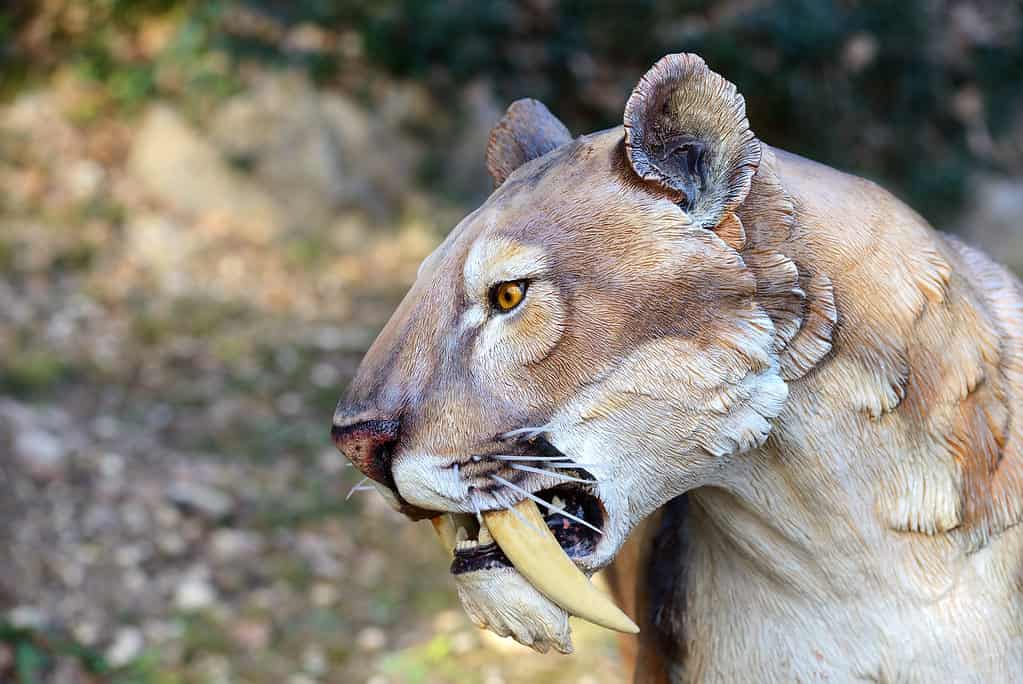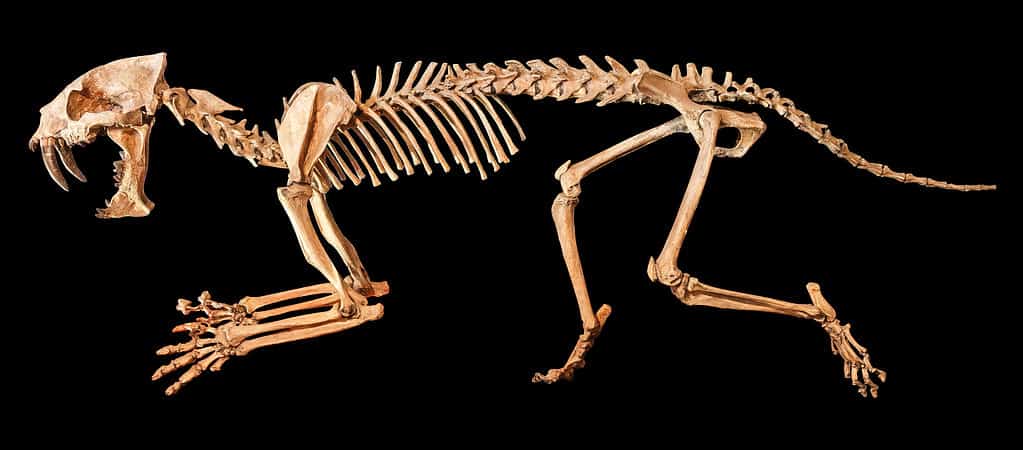The Ice Age is close enough to human history that there is still quite a collective interest in it. During the Ice Age, unique creatures walked the earth. Today, we will be taking a look at one of the most famous Ice Age creatures ever to live: the saber tooth tiger! Specifically, we will be exploring when these large cats went extinct. Without further ado, let’s dive in! When did these incredible tigers go extinct?
When Did Saber-Tooth Tigers Go Extinct?

©Sfocato/Shutterstock.com
The last of the saber tooth tigers went extinct around 10,000 years ago, almost in direct correlation with the end of the last period of global glaciation known as the Ice Age.
Saber-toothed tigers, also known as Smilodon, were large predatory cats that lived during the Pleistocene epoch, which lasted from 2.5 million to 11,700 years ago. They are known for their elongated, razor-sharp canine teeth, which measured up to 7 inches long.
These tigers were apex predators and used their teeth to pierce the throats of their prey. They went extinct around 10,000 years ago, during the end of the last Ice Age. The reasons for their extinction are still debated, but it is thought that a combination of human hunting and climate change may have played a role.
Understanding the Types of Saber-Tooth Tigers
When people talk about “saber tooth tigers,” they think of current-day tigers. Scientifically, however, things are a bit more complicated. Saber-toothed cats are a large group of sometimes-related animals with multiple families and groupings, each quite different. There are examples of convergent evolution happening in different parts of the world at different times in history.
The term “saber-tooth” refers to an ecomorph (a group of species with a similar role, even if they are geographically or physically different) consisting of various groups of extinct predators. These predators are known for their specially evolved teeth.
Smilodon is the most famous genus of the group and contains three members, Smilodon gracilis, Smilodon populator, and Smilodon fatalis. They are members of the subfamily Machairodontinaem which has three tribes: Metailurini (false saber-tooths), Homotherini (scimitar-toothed cats), and Smilodontini (dirk-toothed cats).
It is important to note that the saber-toothed cat is not actually a tiger but rather a member of the cat family, and the term is often used as a catchall for any ancient cat with large canines. Despite this, Smilodon is still one of the best-known members of the group, and depictions can be seen in films, shows, and more today!
Where Did Saber-Tooth Tigers Live?

©Sasha Samardzija/Shutterstock.com
The entire population of “saber-toothed cats,” most of which can be found within the subfamily Machairodontinaem, were extremely widespread.
The Machairodontinae subfamily of carnivoran mammals, also known as saber-toothed cats, were widely distributed during their time on Earth. They were found on several continents, including Asia, Africa, North America, South America, and Europe. They lived from the Miocene to the Pleistocene epochs, lasting from about 2.5 million to 13,000 years ago. Furthermore, they roamed diverse habitats, including forests, grasslands, and deserts.
Saber-toothed cat remains have been found in China and in Africa, namely in Egypt and South Africa.
In North America, remains were found in California, Florida, and Texas. Remains were also found In South America and Europe.
Why Did Saber-Tooth Tigers Go Extinct?
Scientists are still considering the exact reasons why saber-toothed cats went extinct. However, several theories have been proposed to explain their disappearance. One theory is that human hunting played a significant role in their extinction. As human populations grew and expanded into new areas, they likely competed with saber-toothed cats for the same prey. This probably led to a decline in their population.
Another theory is that climate change played a role in their extinction. The end of the last Ice Age, which occurred around 10,000 years ago, brought about significant environmental changes. These include a shift in vegetation patterns and a decline in large mammals, which the cats relied on for food.
It’s probably most likely that a combination of human hunting and climate change contributed to their extinction.
Did Humans Live With the Saber-Tooth Tiger?

©Puwadol Jaturawutthichai/Shutterstock.com
The evidence on whether humans lived with saber-toothed tigers is still unsure, although it’s looking more likely with recent discoveries. Some scientists believe that early human populations did coexist with these cats in certain regions, while others argue that human arrival in these regions came after their extinction.
There have been some discoveries in North and South America of human and Smilodon remains in the same archaeological site. These suggest that these cats and humans coexisted in these regions. In addition, remains were found in Europe of cats that were historically thought to have gone extinct 300,000 years ago.
It is important to note that the coexistence of humans and saber tooth cats would have varied depending on the region and the time period. More research is needed to understand the relationship between these two species fully.
Up Next:
- Saber-Toothed Tiger
- Shockingly, This Saber-Toothed Predator Wasn’t Related To Cats
- The Largest Saber Toothed Marsupial Weighed Nearly 300lbs
The photo featured at the top of this post is © Sfocato/Shutterstock.com
Thank you for reading! Have some feedback for us? Contact the AZ Animals editorial team.






